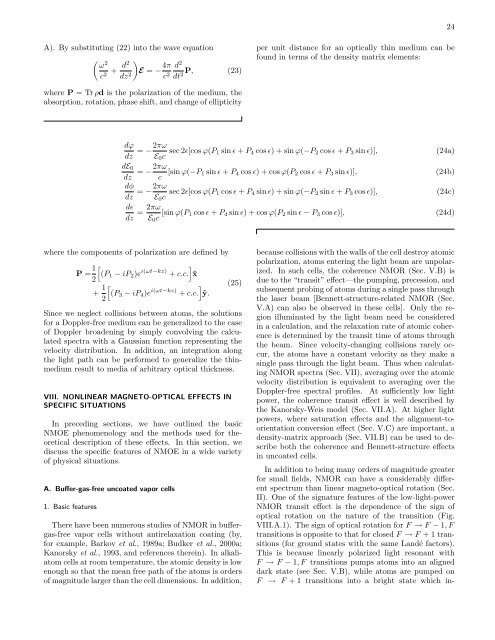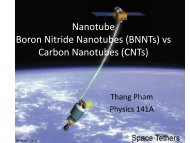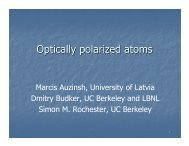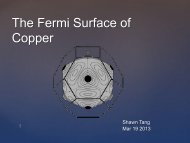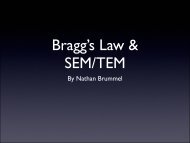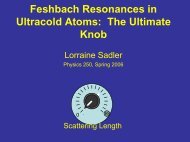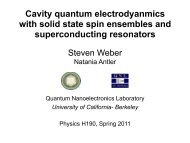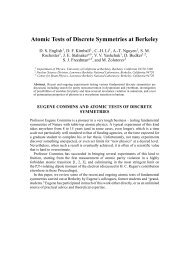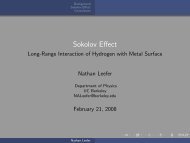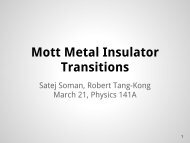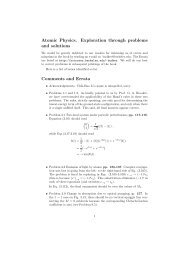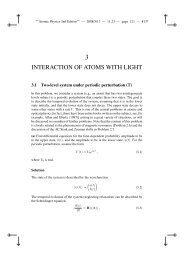Resonant nonlinear magneto-optical effects in atomsâ - The Budker ...
Resonant nonlinear magneto-optical effects in atomsâ - The Budker ...
Resonant nonlinear magneto-optical effects in atomsâ - The Budker ...
You also want an ePaper? Increase the reach of your titles
YUMPU automatically turns print PDFs into web optimized ePapers that Google loves.
24<br />
A). By substitut<strong>in</strong>g (22) <strong>in</strong>to the wave equation<br />
( ) ω<br />
2<br />
c 2 + d2<br />
dz 2 E = − 4π d 2<br />
c 2 P, (23)<br />
dt2 per unit distance for an <strong>optical</strong>ly th<strong>in</strong> medium can be<br />
found <strong>in</strong> terms of the density matrix elements:<br />
where P = Tr ρd is the polarization of the medium, the<br />
absorption, rotation, phase shift, and change of ellipticity<br />
dϕ<br />
dz = −2πω E 0 c sec 2ɛ[cos ϕ(P 1 s<strong>in</strong> ɛ + P 4 cos ɛ) + s<strong>in</strong> ϕ(−P 2 cos ɛ + P 3 s<strong>in</strong> ɛ)],<br />
(24a)<br />
dE 0<br />
dz = −2πω c [s<strong>in</strong> ϕ(−P 1 s<strong>in</strong> ɛ + P 4 cos ɛ) + cos ϕ(P 2 cos ɛ + P 3 s<strong>in</strong> ɛ)], (24b)<br />
dφ<br />
dz = −2πω E 0 c sec 2ɛ[cos ϕ(P 1 cos ɛ + P 4 s<strong>in</strong> ɛ) + s<strong>in</strong> ϕ(−P 2 s<strong>in</strong> ɛ + P 3 cos ɛ)],<br />
(24c)<br />
dɛ<br />
dz = 2πω<br />
E 0 c [s<strong>in</strong> ϕ(P 1 cos ɛ + P 4 s<strong>in</strong> ɛ) + cos ϕ(P 2 s<strong>in</strong> ɛ − P 3 cos ɛ)],<br />
(24d)<br />
where the components of polarization are def<strong>in</strong>ed by<br />
P = 1 [<br />
]<br />
(P 1 − iP 2 )e i(ωt−kz) + c.c. ˆx<br />
2<br />
+ 1 [<br />
]<br />
(P 3 − iP 4 )e i(ωt−kz) + c.c. ŷ.<br />
2<br />
(25)<br />
S<strong>in</strong>ce we neglect collisions between atoms, the solutions<br />
for a Doppler-free medium can be generalized to the case<br />
of Doppler broaden<strong>in</strong>g by simply convolv<strong>in</strong>g the calculated<br />
spectra with a Gaussian function represent<strong>in</strong>g the<br />
velocity distribution. In addition, an <strong>in</strong>tegration along<br />
the light path can be performed to generalize the th<strong>in</strong>medium<br />
result to media of arbitrary <strong>optical</strong> thickness.<br />
VIII. NONLINEAR MAGNETO-OPTICAL EFFECTS IN<br />
SPECIFIC SITUATIONS<br />
In preced<strong>in</strong>g sections, we have outl<strong>in</strong>ed the basic<br />
NMOE phenomenology and the methods used for theoretical<br />
description of these <strong>effects</strong>. In this section, we<br />
discuss the specific features of NMOE <strong>in</strong> a wide variety<br />
of physical situations.<br />
A. Buffer-gas-free uncoated vapor cells<br />
1. Basic features<br />
<strong>The</strong>re have been numerous studies of NMOR <strong>in</strong> buffergas-free<br />
vapor cells without antirelaxation coat<strong>in</strong>g (by,<br />
for example, Barkov et al., 1989a; <strong>Budker</strong> et al., 2000a;<br />
Kanorsky et al., 1993, and references there<strong>in</strong>). In alkaliatom<br />
cells at room temperature, the atomic density is low<br />
enough so that the mean free path of the atoms is orders<br />
of magnitude larger than the cell dimensions. In addition,<br />
because collisions with the walls of the cell destroy atomic<br />
polarization, atoms enter<strong>in</strong>g the light beam are unpolarized.<br />
In such cells, the coherence NMOR (Sec. V.B) is<br />
due to the “transit” effect—the pump<strong>in</strong>g, precession, and<br />
subsequent prob<strong>in</strong>g of atoms dur<strong>in</strong>g a s<strong>in</strong>gle pass through<br />
the laser beam [Bennett-structure-related NMOR (Sec.<br />
V.A) can also be observed <strong>in</strong> these cells]. Only the region<br />
illum<strong>in</strong>ated by the light beam need be considered<br />
<strong>in</strong> a calculation, and the relaxation rate of atomic coherence<br />
is determ<strong>in</strong>ed by the transit time of atoms through<br />
the beam. S<strong>in</strong>ce velocity-chang<strong>in</strong>g collisions rarely occur,<br />
the atoms have a constant velocity as they make a<br />
s<strong>in</strong>gle pass through the light beam. Thus when calculat<strong>in</strong>g<br />
NMOR spectra (Sec. VII), averag<strong>in</strong>g over the atomic<br />
velocity distribution is equivalent to averag<strong>in</strong>g over the<br />
Doppler-free spectral profiles. At sufficiently low light<br />
power, the coherence transit effect is well described by<br />
the Kanorsky-Weis model (Sec. VII.A). At higher light<br />
powers, where saturation <strong>effects</strong> and the alignment-toorientation<br />
conversion effect (Sec. V.C) are important, a<br />
density-matrix approach (Sec. VII.B) can be used to describe<br />
both the coherence and Bennett-structure <strong>effects</strong><br />
<strong>in</strong> uncoated cells.<br />
In addition to be<strong>in</strong>g many orders of magnitude greater<br />
for small fields, NMOR can have a considerably different<br />
spectrum than l<strong>in</strong>ear <strong>magneto</strong>-<strong>optical</strong> rotation (Sec.<br />
II). One of the signature features of the low-light-power<br />
NMOR transit effect is the dependence of the sign of<br />
<strong>optical</strong> rotation on the nature of the transition (Fig.<br />
VIII.A.1). <strong>The</strong> sign of <strong>optical</strong> rotation for F → F − 1, F<br />
transitions is opposite to that for closed F → F + 1 transitions<br />
(for ground states with the same Landé factors).<br />
This is because l<strong>in</strong>early polarized light resonant with<br />
F → F − 1, F transitions pumps atoms <strong>in</strong>to an aligned<br />
dark state (see Sec. V.B), while atoms are pumped on<br />
F → F + 1 transitions <strong>in</strong>to a bright state which <strong>in</strong>-


